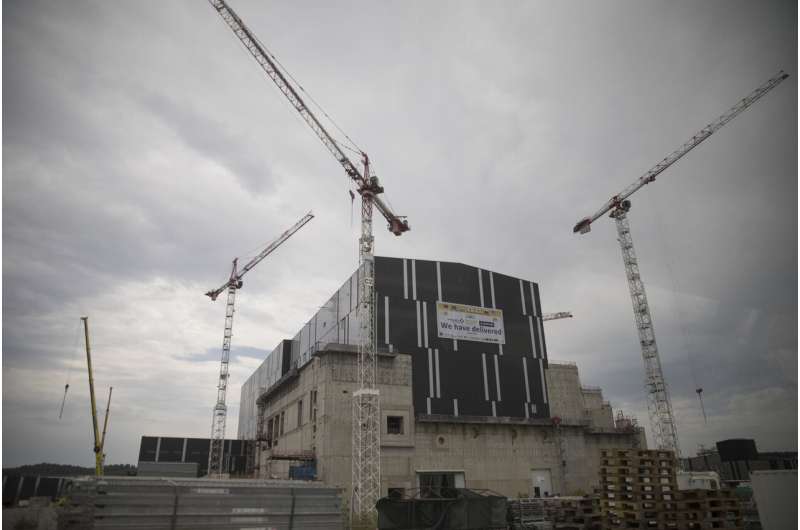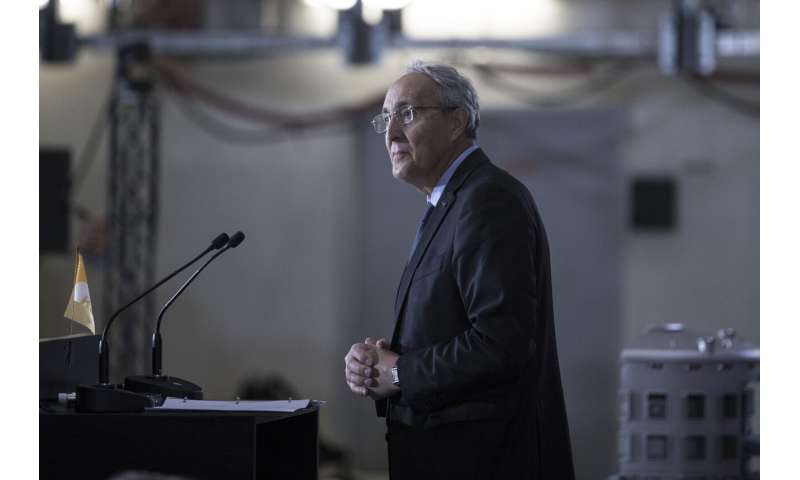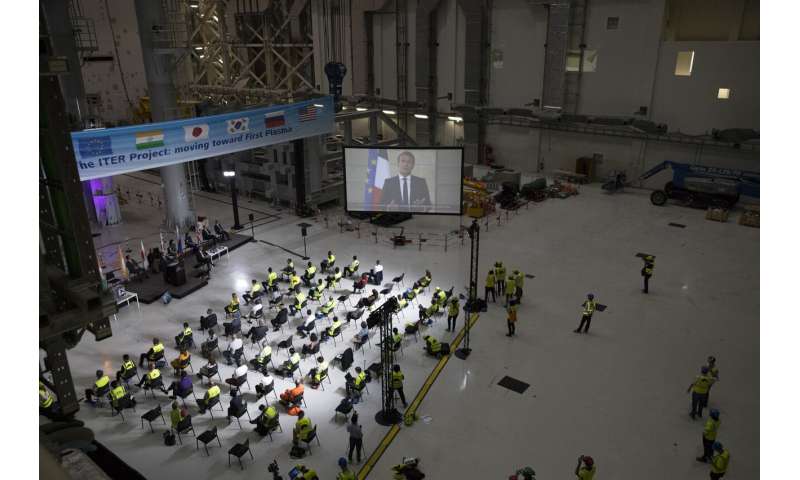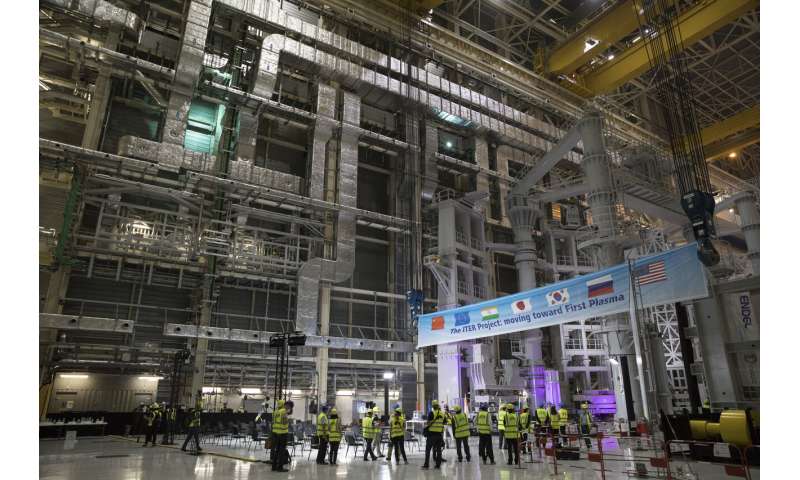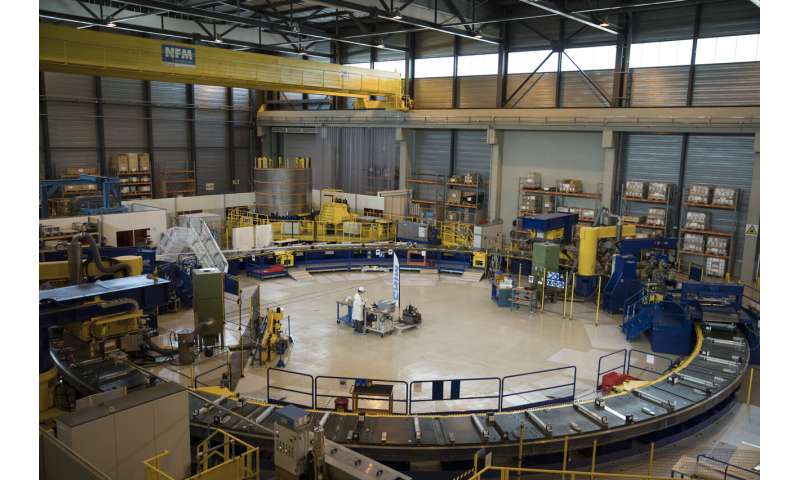Major Nuclear Fusion Breakthrough Achieved In The US
National Ignition Facility target chamber. Image Credit: U.S. Department of Energy
August 8 was a momentous day for nuclear fusion in the US, as an experiment at the National Ignition Facility (NIF) at Lawrence Livermore National Laboratory made a leap towards the threshold of “ignition” of inertial confinement fusion.
This approach differs from the magnetic confinement seen in fusion reactors across the world such as Tokamak and Stellarators. Energy is not extracted by a continuous flow of extremely hot fusing plasma – in inertial confinement, fusion instead is extracted from discrete events. Small pellets of fuel are ignited by heating and compressing, creating fusion and releasing a huge amount of energy that can be turned into electricity.
For fusion to be self-sustaining – getting more energy out than put in – it has to surpass the fusion ignition threshold. Data from the recent test at NIF is still being analyzed, but it appears to be right at the cusp. It released 1.3 Megajoules of fusion energy – an eight-fold improvement on the test conducted this past spring, and 25 times better than the record-breaking experiments in 2018.
The facility is the size of three football fields and uses lasers on a very small target. As it is heated, it creates a hot spot the diameter of a human hair, releasing 10 quadrillion watts of fusion power for 100 trillionths of a second.
“Gaining experimental access to thermonuclear burn in the laboratory is the culmination of decades of scientific and technological work stretching across nearly 50 years,” Los Alamos National Laboratory Director Thomas Mason said in a statement. “This enables experiments that will check theory and simulation in the high energy density regime more rigorously than ever possible before and will enable fundamental achievements in applied science and engineering.”
Nuclear fusion could revolutionize energy production by allowing for more energy without radioactive waste products, dangerous aerosols, or greenhouse gases emissions. Full-scale nuclear fusion power plants are being built already to test their viability.
If inertial confinement fusion can be finally achieved, it could be used to produce different types of nuclear fusion power plants. It can also allow the study of extreme physical environments where heat and pressure are incredible.
However, it’s not just about civil uses. In the United States, the NIF has a role in the nuclear weapons Stockpile Stewardship program.
“These extraordinary results from NIF advance the science that NNSA depends on to modernize our nuclear weapons and production as well as open new avenues of research,” said Jill Hruby, DOE undersecretary for Nuclear Security and NNSA Administrator.
Another Nuclear Fusion Record Just Got Broken in South Korea
Scientists working to make nuclear fusion a viable reality have smashed another record, after the Korean Superconducting Tokamak Advanced Research (KSTAR) reactor in South Korea maintained 'high performance' plasma in a stable state for 70 seconds this week– the longest ever recorded for this type of reaction.
Containing this ultra-hot type of matter is key to unlocking nuclear fusion, so it's a big step forward in our attempts to make this clean, safe, and virtually limitless source of energy something we can rely on.
Unlike nuclear fission, which our existing nuclear power plants achieve by splitting atoms, nuclear fusion involves fusing atoms together at incredibly high temperatures - the same reaction that powers our Sun.
If we can manage to control the reaction safely and sustainably it would be huge, because nuclear fusion can generate power for thousands of years using little more than salt water, and without putting out nuclear waste. And the Korean reactor just took us a step closer to that.
The KSTAR reactor is housed at the National Fusion Research Institute (NFRI) and is a tokamak-type reactor, where plasma blobs reaching temperatures of up to 300 million degrees Celsius (about 540 million degrees Fahrenheit) are held in place by super-powerful magnetic fields.
If the blobs can be contained for long enough, hydrogen atoms can fuse together to create heavier helium atoms, releasing energy – a similar process is happening on the Sun, which is why reactors are sometimes described as trying to put "a star in a jar".
And while the reactors of today take up much more energy than they produce, each time a record like this is broken, scientists get closer to their ultimate goal.
"This is a huge step forward for [the] realisation of the fusion reactor," the NFRI said in a statement, World Nuclear News reports.
There are plenty of variables scientists can alter to tweak nuclear fusion reactions and different ways they can be measured: from pressure to temperature to time.
Usually, there's a trade-off between these three variables, and indeed other reactors have managed to sustain plasma for longer periods of time – but with the KSTAR we're talking about a "high performance" plasma, which is better suited for nuclear fusion.
At the same time, the researchers at the NFRI have also developed a new plasma "operation mode" that they hope will enable reactions to handle greater pressures at lower temperatures in the future.
And getting the whole process more efficient is important if we're to get nuclear fusion working at the right scale.
If scientists can crack the "star in a jar" problem, we'd have a nuclear energy source that's far safer than the nuclear fission plants we rely on now, because no radioactive waste is produced and there's no chance of a plant meltdown.
We should note that the results haven't been published in a journal or independently verified yet, so we'll have to wait for confirmation that 70 seconds really is the new benchmark to hit for this high-performance plasma.
But as the KSTAR reactor continues to push the boundaries of what's possible, it should help bring scientists closer and closer to figuring out how to harness the potential of nuclear fusion.
As NFRI president Keeman Kim puts it: "We will exert efforts for KSTAR to continuously produce world-class results, and to promote international joint research among nuclear fusion researchers."
France's global nuclear fusion device a puzzle of huge parts
Assembly hall at the construction site of the ITER ( the International Thermonuclear Experimental Reactor), where components for the ITER Tokamak will be pre-assembled before integration into the machine in the CEN of Cadarache, in Saint-Paul-Lez-Durance, southern France, Tuesday, July 28, 2020. A project of daunting proportions and giant ambitions replicating the energy of the sun is entering a critical phase as scientists and technicians begin piecing together massive parts built around the globe of a nuclear fusion device, an experiment aimed at showing that clean energy, free of carbon emissions, can keep our planet humming. (AP Photo/Daniel Cole)
A hugely ambitious project to replicate the energy of the sun is entering a critical phase, as scientists and technicians in southern France begin assembling giant parts of a nuclear fusion device, an international experiment aimed to develop the ultimate clean energy source.
World leaders involved in the project, or their representatives, on Tuesday appeared virtually at a ceremony for the start of the new stage of the International Thermonuclear Experimental Reactor, or ITER, noting that work has proceeded despite the COVID-19 pandemic in many of the 35 contributing countries.
"Clearly, the pandemic impacted the initial schedule," said ITER's director-general, Bernard Bigot, who led the ceremony at Saint-Paul-les-Durance, northeast of Marseille. He said none of the on-the-ground staff has contracted COVID-19.
Scientists have long sought to mimic the process of nuclear fusion that occurs inside the sun, arguing that it could provide an almost limitless source of cheap, safe and clean electricity. Unlike in existing fission reactors, which split plutonium or uranium atoms, there's no risk of an uncontrolled chain reaction with fusion and it doesn't produce long-lived radioactive waste.
The project "seeks to create an artificial sun," said South Korean President Moon Jae-in. "An artificial sun is an energy source of dreams."
The base of the cryostat sits inside the bioshield of the ITER Tokamak in Saint-Paul-Lez-Durance, southern France, Tuesday, July 28, 2020. A project of daunting proportions and giant ambitions replicating the energy of the sun is entering a critical phase as scientists and technicians begin piecing together massive parts built around the globe of a nuclear fusion device, an experiment aimed at showing that clean energy, free of carbon emissions, can keep our planet humming. (AP Photo/Daniel Cole)
Among other elements, Korea is manufacturing four sectors of a vacuum vessel, a hermetically sealed chamber in which plasma particles, derived from heated hydrogen gas, spiral without touching walls. European countries are building five other sectors.
French President Emmanuel Macron hailed ITER as a "promise of peace" because it brings together countries that decided to forego differences for the "common good." China, the U.S., India, Russia, South Korea and nations of the European Union are taking part in the project.
There was no sign of the acute discord currently roiling ties between the U.S. and China, and India and China.
Indian Prime Minister Narendra Modi, in a statement read by the Indian ambassador to France, called international collaboration "a perfect symbol of the age-old Indian belief ... (that) the world is one family."
A worker walks by the ITER poloidal field coil #5 designed to shape plasma and meant for the assembly of the ITER Tokamak in Saint-Paul-Lez-Durance, southern France,, Tuesday, July 28, 2020. A project of daunting proportions and giant ambitions replicating the energy of the sun is entering a critical phase as scientists and technicians begin piecing together massive parts built around the globe of a nuclear fusion device, an experiment aimed at showing that clean energy, free of carbon emissions, can keep our planet humming. (AP Photo/Daniel Cole)
Bigot compared the milestone phase getting under way to assembling a giant, three dimensional puzzle that "must (have) the precision of a Swiss watch."
Billed as the world's largest science project, ITER is gigantic. The circular device, called a tokamak, has a 30-meter circumference, stands 30 meters (100 feet) high, and is made up of more than a million parts constructed in numerous countries.
Some pieces transported to France weigh several hundred tons. Tools to put the reactor together match that size, with giant lifts that must transfer components over the walls and down into "the pit." A key component being built by the U.S., the Central Solenoid, is the most powerful of ITER's numerous magnets. Together, they will be strong enough to lift an aircraft carrier.
The project begun in 2006 is far from over. The experimental reactor is to head for another landmark moment in five years, described as a "trial run" when scientists launch what is called "First Plasma" showing that the machine functions, including magnetic fields and other operations.
A worker stands in the middle of an ITER poloidal field coil meant for the assembly of the ITER Tokamak in the CEN of Cadarache, in Saint-Paul-Lez-Durance, southern France, Tuesday, July 28, 2020. A project of daunting proportions and giant ambitions replicating the energy of the sun is entering a critical phase as scientists and technicians begin piecing together massive parts built around the globe of a nuclear fusion device, an experiment aimed at showing that clean energy, free of carbon emissions, can keep our planet humming. (AP Photo/Daniel Cole)
Director-General of the ITER Organization, Bernard Bigot speaks to representatives and journalists in the assembly hall of the ITER ( the International Thermonuclear Experimental Reactor), where components for the ITER Tokamak will be pre-assembled before integration into the machine in Saint-Paul-Lez-Durance, southern France, Tuesday, July 28, 2020. A project of daunting proportions and giant ambitions replicating the energy of the sun is entering a critical phase as scientists and technicians begin piecing together massive parts built around the globe of a nuclear fusion device, an experiment aimed at showing that clean energy, free of carbon emissions, can keep our planet humming. (AP Photo/Daniel Cole)
A worker walks through large scale assembly tools in the assembly hall of the ITER ( the International Thermonuclear Experimental Reactor), where components for the ITER Tokamak will be pre-assembled before integration into the machine in Saint-Paul-Lez-Durance, southern France, T Tuesday, July 28, 2020. A project of daunting proportions and giant ambitions replicating the energy of the sun is entering a critical phase as scientists and technicians begin piecing together massive parts built around the globe of a nuclear fusion device, an experiment aimed at showing that clean energy, free of carbon emissions, can keep our planet humming. (AP Photo/Daniel Cole)
The ITER electrical grid is pictured in front of the assembly hall at the construction site of the ITER (the International Thermonuclear Experimental Reactor), where components for the ITER Tokamak will be pre-assembled before integration into the machine in Saint-Paul-Lez-Durance, southern France, Tuesday, July 28, 2020. A project of daunting proportions and giant ambitions replicating the energy of the sun is entering a critical phase as scientists and technicians begin piecing together massive parts built around the globe of a nuclear fusion device, an experiment aimed at showing that clean energy, free of carbon emissions, can keep our planet humming. (AP Photo/Daniel Cole)
French President Emmanuel Macron, on screen, delivers a speech virtually to representatives and journalists in the assembly hall of the ITER (the International Thermonuclear Experimental Reactor), where components for the ITER Tokamak will be pre-assembled before integration into the machine in Saint-Paul-Lez-Durance, southern France, Tuesday, July 28, 2020. A project of daunting proportions and giant ambitions replicating the energy of the sun is entering a critical phase as scientists and technicians begin piecing together massive parts built around the globe of a nuclear fusion device, an experiment aimed at showing that clean energy, free of carbon emissions, can keep our planet humming. (AP Photo/Daniel Cole)
Members of the media stand in the assembly hall at the ITER (the International Thermonuclear Experimental Reactor), where components for the ITER Tokamak will be pre-assembled before integration into the machine in the CEN of Cadarache, in Saint-Paul-Lez-Durance, southern France, Tuesday, July 28, 2020. A project of daunting proportions and giant ambitions replicating the energy of the sun is entering a critical phase as scientists and technicians begin piecing together massive parts built around the globe of a nuclear fusion device, an experiment aimed at showing that clean energy, free of carbon emissions, can keep our planet humming. (AP Photo/Daniel Cole)
Director-General of the ITER Organization, Bernard Bigot walks by a portion of the cryostat meant for the assembly of the ITER Tokamak in the CEN of Cadarache, in Saint-Paul-Lez-Durance, southern France, Tuesday, July 28, 2020. A project of daunting proportions and giant ambitions replicating the energy of the sun is entering a critical phase as scientists and technicians begin piecing together massive parts built around the globe of a nuclear fusion device, an experiment aimed at showing that clean energy, free of carbon emissions, can keep our planet humming. (AP Photo/Daniel Cole)
A worker stands in the middle of an ITER poloidal field coil meant for the assembly of the ITER Tokamak in the CEN of Cadarache, in Saint-Paul-Lez-Durance, southern France, Tuesday, July 28, 2020. A project of daunting proportions and giant ambitions replicating the energy of the sun is entering a critical phase as scientists and technicians begin piecing together massive parts built around the globe of a nuclear fusion device, an experiment aimed at showing that clean energy, free of carbon emissions, can keep our planet humming. (AP Photo/Daniel Cole)
Bigot, the ITER's director-general, called fusion energy a "miracle for our planet."
He said that smaller experiments are complementary to ITER. Bigot predicts a bright future for his international baby, saying he foresees a scaled-up ITER, perhaps twice as large, to provide power to the grid. But its viability and economic competitiveness must first be demonstrated, he said.
The project's estimated cost just for the EU was about 20 billion euros ($23.5 billion), Bigot told reporters. He said a full price tag was difficult to estimate because participating countries make their own contributions.

